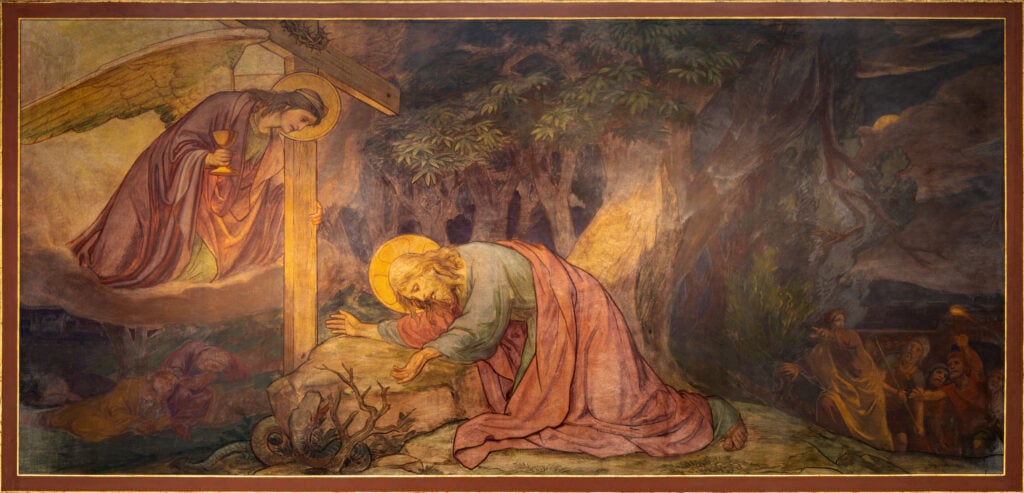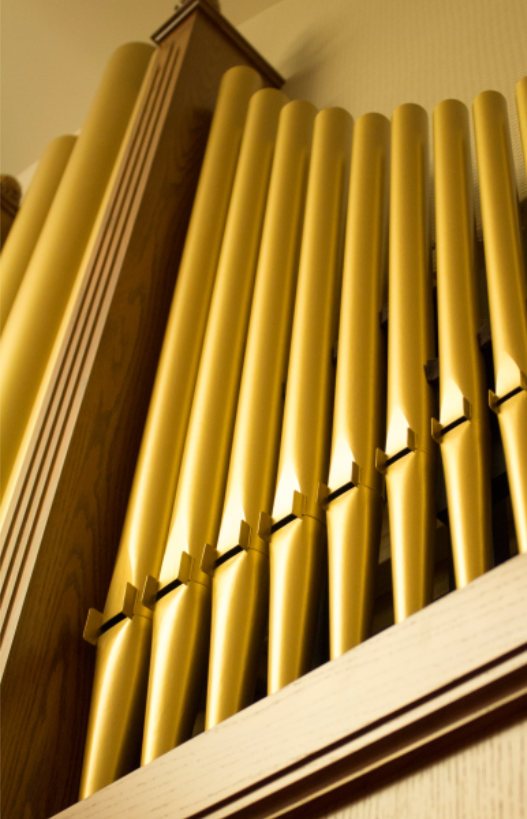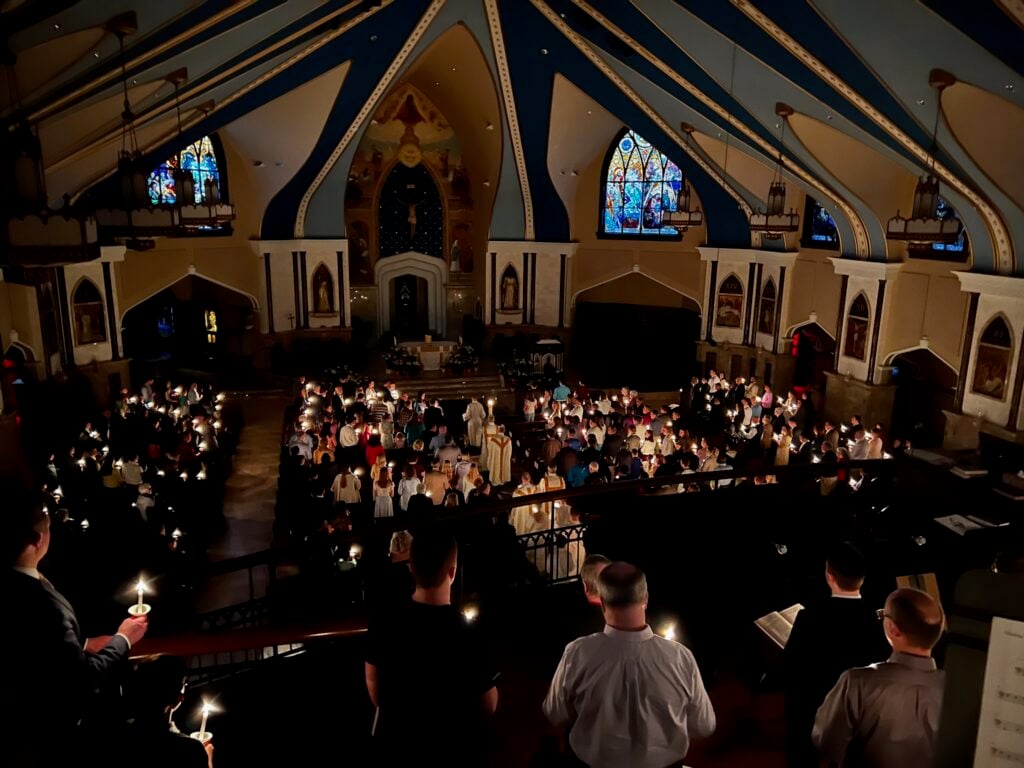Holy Week is upon us! This is the most important week in the liturgical year, and there is a lot of depth to the celebrations we are about to participate in. As a primer for the Triduum, I hope the information you read below will help you enter more deeply into the liturgies we celebrate.
Triduum
The word ‘triduum’ means ‘three days,’ in Latin. The “Sacred Paschal Triduum” (synonymous with ‘Easter Triduum’) is the three days spent in remembrance of the Crucifixion, Death, and Resurrection of Jesus Christ. We also call this saving action the ‘Paschal Mystery.’ This is without a doubt the highest celebration of the liturgical year, and “constitutes the essence of Christian worship.”[1] The Triduum officially begins with the Mass of the Lord’s Supper on Holy Thursday, and concludes with the Easter Vigil on Saturday night. The triduum liturgy is one liturgy celebrated across the three days, (as opposed to three separate celebrations on each day). More on that below…
Holy Thursday
On Holy Thursday we celebrate the Mass of the Lord’s Supper. We remember the Last Supper where Jesus washed the feet of his disciples, commanding them to do likewise. “I give you a new commandment, that you love one another as I have loved you.” (John 13:34) He then broke bread and blessed the wine, giving it to his disciples, and in doing so instituted the Eucharist. There is a special veneration of the Eucharist that takes place at the ‘end’ of this liturgy, where the congregation processes out to what is called the ‘altar of repose’ where we can take some time to “remain here and keep watch” (Mark 14:34) like the disciples in the garden at Gethsemane. Time for prayer in adoration is given throughout the evening as “an invitation to silent and prolonged adoration of the wondrous sacrament instituted by Jesus on this day.”[2]
Tenebrae
This is outside of the actual triduum, but is a beautiful part of Holy Week worth highlighting. Tenebrae is the name given to the service of Matins (office of readings) and Lauds (morning prayer) on Friday into Saturday of the triduum. These are parts of the Divine Office which consecrated religious and clergy are bound to pray, and we lay faithful are encouraged to participate as well! Our parish already offers Vespers (Evening Prayer) every Sunday, and on the occasion of Holy Week, we offer the Tenebrae service as a unique opportunity to enter more deeply into the paschal mystery. We sing the majority of the service, which is mostly from the book of psalms, the “school of prayer” for us. There are also readings from scripture and ancient texts from Doctors of the Church. This is an opportunity for profound encounter with the Lord during Holy Week, and is likely something you have never experienced before! Consider coming out on Friday and/or Saturday morning at 7am to participate and pray, it is sure to make your experience of the triduum more impactful.
Good Friday
Okay, now back to the Triduum: In the section on Holy Thursday, I hinted that the Holy Thursday Mass does not ‘end.’ That liturgy concludes with the procession to the altar of repose, and after preparing the Eucharist for adoration, there is an informal departure that is not accompanied by any dismissal from the priest. Instead, we depart in silence, and that is exactly how we begin the Good Friday liturgy. Since we didn’t really ‘end’ Holy Thursday’s liturgy, we don’t ‘begin’ a new liturgy today, but continue on to the second of three parts of the triduum liturgy. We do not consecrate any hosts on the altar today (though we do still receive communion with hosts consecrated at Thursday night’s Mass). Today we remember the passion of Jesus Christ, adoring the cross and “commemora[ting] [The Church’s] origin from the side of Christ asleep on the Cross, and intercede[s] for the salvation of the whole world.”[3] This is a somber and heavy liturgy, rightly so! You may recall that the priest and other ministers enter in silence, and prostrate themselves on the floor in front of the sanctuary, signifying “both the abasement of ‘earthly man,’ and also the grief and sorrow of the Church.”[4] It is right to enter into that authentic grief that we feel at the death of Jesus Christ, much as we experience grief at the loss of a loved one. This part of the triduum also ends in silence, and we begin again on Saturday night with the Easter Vigil.
Holy Saturday Vigil
Part three: the finale! This liturgy is the “solemnity of solemnities,”[5] the greatest celebration of the liturgical year. The Holy Easter Vigil in the Night begins outside the church with a fire that is blessed, and our new Easter candle is lit. We process into the church carrying the light of Christ, passing it on from one person to one another, following the ‘paschal candle.’ Just like the Israelites were guided at night by a pillar of fire, we now follow the light of Christ. It is a remarkable thing to see our dark church illuminated by candlelight from the many people who gather to worship in our community. (If I do say so myself, the best view is from the choir loft!) From there, we meditate upon seven Old Testament readings, each accompanied by a responsorial psalm, and two New Testament readings, which bring back the joyous sounds of the ‘Gloria’ and ‘Alleluia’ for the first time since Lent began (save for the Solemnity of St. Joseph on March 19, and Holy Thursday). After that, we celebrate our catechumens and candidates from RCIA who have been studying and praying in preparation to join our Catholic faith in this community. There are Confirmations and Baptisms and First Holy Communions at this liturgy, and it is such a gift to witness these beautiful and brave members of our community partaking in the sacraments for the first time! We, too, renew our baptismal promises at Easter, and are sprinkled with holy water before partaking in the Eucharist with our newly baptized and/or confirmed brothers and sisters. This is a wonderful unitive celebration in the life of the church, and as such, the celebratory character is unmatched in any other liturgy. For my part as a musician, it is always invigorating to sing the great hymns and chants of this day with our magnificent choir, and brass quintet amplifying our praises heavenward!
Well, that’s a lot! But here’s the truth: This is just the beginning. If you want to understand the Triduum—come. Participating in the triduum is one of the best parts of the liturgical year. It is an extra commitment of your time, but that pales in comparison to the saving action of Jesus Christ that we celebrate this week. If the Institution of the Eucharist, Crucifixion, Death, and Resurrection of Jesus Christ isn’t worth more hours of our week, I don’t know what is! Hit ‘record’ on your TV shows, leave scrolling on the phone behind, and devote yourself to more time for encountering the Lord during Holy Week. I often quip that I “don’t ever speak in absolutes, they’re always wrong!” But I’m feeling bold enough to break my rule in this case: Come to the Triduum liturgies, you will not regret it.
[1] Pope Paul VI – Mysterii Paschalis
[2] Directory on Popular Piety and the Liturgy (2001) – Congregation for Divine Worship and the Discipline of the Sacraments, #141
[3] “The Preparation and Celebration of the Easter Feasts: Paschalis Solemnitatis” – Congregation for Divine Worship, #58
[4] Ibid., #65
[5] Ibid., #80




